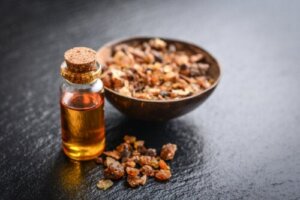Uses, Benefits and Precautions of Myrrh Oil


Reviewed and approved by the pharmacist Franciele Rohor de Souza
Myrrh oil is a product obtained from the steam distillation of the dried sap of a thorny tree known as Commiphora myrrha. It’s characterized by its particular color – ranging from amber to brown – and an earthy aroma that is often used in aromatherapy.
Although it’s popular in religious and spiritual rituals, its therapeutic potential is currently being studied. A review shared in Holistic Nursing Practice tells us that it’s a product abundant in terpenoids, with antibacterial, antiseptic, anesthetic, and antitumor activity. Want to know more about it?
Uses and benefits of myrrh oil
Myrrh is a tree native to northeast Africa and southwest Asia. Throughout history, it has been used as incense and as a perfume because of its pungent aroma. Popular beliefs associate its presence in the home with protection against negative energies. In addition, it’s used for spiritual purposes.
However, as detailed in a review shared in Biomedical Papers, more than 100 years ago its compounds began to be identified, as well as its medicinal uses. It was determined that it’s an interesting source of bioactive sesquiterpenes that confer antiseptic, anti-inflammatory, analgesic, and healing properties.
Today, myrrh oil – a by-product of the resin extracted from the tree – is the most widely used presentation for medicinal purposes. It’s used as a topical treatment for wounds, infections and bruises. Here are its main applications.
You may be interested in: 20 Essential Oils You Should Have During the Winter
Helps eliminate harmful bacteria
Since ancient times, myrrh incense has been used to purify the air and reduce the spread of bacterial infections. Today, both myrrh oil and incense smoke are still used for this purpose.
A study shared in the Journal of Ethnopharmacology reported that myrrh oil has antimicrobial properties. In addition, burning myrrh and frankincense can decrease airborne bacteria counts by up to 68%.
A test tube study in the journal Antibiotics found that a low, 0.1% dilution of myrrh oil was useful in combating the bacterium Borrelia burgdorferi, which causes Lyme disease.
Further studies are needed to evaluate these properties. Still, these findings suggest that myrrh oil may be a good candidate for fighting some drug-resistant bacteria.

Supports skincare
In traditional medicine, myrrh oil has been used as a topical remedy for skin infections and wounds. In this connection, research reported in Pharmaceutical Biology revealed that Commiphora myrrha species has antifungal properties, which support the treatment of fungal infections.
In turn, a test tube study in Biochim Open reported that a mixture of oils containing myrrh helped to promote the relief of skin wounds. In particular, they inhibited protein molecules associated with inflammation and regeneration processes, suggesting their anti-inflammatory and wound-healing effect.
A publication in Chemistry & Biodiversity also supports these effects. In the study, a mixture of myrrh oil with sandalwood oil helped eliminate infection-causing microbes on skin wounds.
Helps decrease pain and inflammation
In traditional medicine, myrrh oil is considered a natural pain reliever. Evidence suggests that its compounds interact with opioid receptors, which send signals to the brain to soothe pain. In addition, it inhibits the production of chemicals that increase the level of inflammation.
That said, the product is often suggested in the following ailments:
- Headaches
- Inflammation and joint pain
- Muscle pain
Supports oral health
The antimicrobial properties of myrrh oil are harnessed in the manufacture of mouthwashes and toothpastes. Due to its composition, it decreases gum inflammation and plaque build-up. Thus, it supports the treatment of gingivitis.
In a study shared in the American Journal of Research Communication, patients with Behcet’s disease – an inflammatory disorder – experienced an improvement in symptoms after using a myrrh mouthwash. Specifically, 50% had complete pain relief, while 19% had complete healing of mouth sores.
However, caution should be exercised when using myrrh rinses. It’s a product that shouldn’t be ingested, as it can be toxic.
Combats free radicals
Test tube and animal studies show that myrrh oil has an antioxidant potential that surpasses that of vitamin E. Thus, it’s a great ally in inhibiting the negative effects of free radicals.
However, more evidence is needed to corroborate these effects in humans. To date, it isn’t known whether inhalation or topical use of myrrh oil – which are the safe forms of use – can exert this same effect.
Other possible uses of myrrh oil
For now, research on the effects of myrrh oil is still ongoing. Given the lack of conclusive evidence, cautious use is recommended, only externally.
Study results also suggest the following uses:
- Sun protection. In a study shared in the Journal of Drugs in Dermatology, an SPF 15 sunscreen with myrrh oil was more effective in inhibiting the effects of the sun’s rays compared to a sunscreen alone.
- Mold elimination. In the home, myrrh oil can help eliminate molds that grow on walls and food.
- Antitumor potential. It isn’t a cancer treatment and evidence is still insufficient. However, test tube studies suggest that components of myrrh oil may help slow the growth of malignant cells.
Read more: Neroli Essential Oil: Uses, Benefits, and Contraindications
Risks and precautions when using myrrh oil
Myrrh oil alone can be irritating. Therefore, like other essential oils, it’s sufficient to use only a few drops. In fact, for topical use, it’s advisable to combine it with a carrier oil, such as coconut, almond or jojoba oil.
The best way is to do a small patch test before using it over a wider area. Apply a little of the product to one small area of the skin. If after 2 hours there are no undesired reactions, it can be used without any problem.
Under no circumstances should it be taken orally, as it may be toxic. Some symptoms of ingestion include digestive discomfort, such as nausea, vomiting, diarrhea, and abdominal swelling. In addition, it is contraindicated in the following cases:
- Diabetes
- Pregnancy and lactation
- Cardiac diseases
- Treatments with anticoagulants
- Patients about to undergo surgery

Mode of use
Myrrh oil is used topically, inhaled, or as a compound in dental care products.
- To avoid the risk of skin irritation it should be diluted with carrier oils (grape seed, almond, coconut, jojoba, among others). The proportions should be 3 to 6 drops per 5 milliliters of carrier oil.
- To inhale it, 4 to 6 drops of oil should be placed in a diffuser. Another option is to add it to hot water and take advantage of the vapors.
What to remember about myrrh oil?
Due to its aroma and properties, myrrh oil is used in traditional medicine as a natural pain reliever, disinfectant, and an antimicrobial. For now, studies support many of its properties. However, it should be reserved for external use, as oral ingestion is toxic.
Research on this ingredient is ongoing. And although the findings are promising, they aren’t sufficient to consider it a first-choice treatment for diseases. Therefore, its use should be merely complementary.
All cited sources were thoroughly reviewed by our team to ensure their quality, reliability, currency, and validity. The bibliography of this article was considered reliable and of academic or scientific accuracy.
- Nomicos EY. Myrrh: medical marvel or myth of the Magi? Holist Nurs Pract. 2007 Nov-Dec;21(6):308-23. doi: 10.1097/01.HNP.0000298616.32846.34. PMID: 17978635.
- Hanus LO, Rezanka T, Dembitsky VM, Moussaieff A. Myrrh–Commiphora chemistry. Biomed Pap Med Fac Univ Palacky Olomouc Czech Repub. 2005 Jun;149(1):3-27. doi: 10.5507/bp.2005.001. PMID: 16170385.
- Ljaljević Grbić M, Unković N, Dimkić I, Janaćković P, Gavrilović M, Stanojević O, Stupar M, Vujisić L, Jelikić A, Stanković S, Vukojević J. Frankincense and myrrh essential oils and burn incense fume against micro-inhabitants of sacral ambients. Wisdom of the ancients? J Ethnopharmacol. 2018 Jun 12;219:1-14. doi: 10.1016/j.jep.2018.03.003. Epub 2018 Mar 9. PMID: 29530608.
-
Feng J, Shi W, Miklossy J, Tauxe GM, McMeniman CJ, Zhang Y. Identification of Essential Oils with Strong Activity against Stationary Phase Borrelia burgdorferi. Antibiotics (Basel). 2018 Oct 16;7(4):89. doi: 10.3390/antibiotics7040089. PMID: 30332754; PMCID: PMC6316231.
- Mahboubi M, Kashani LM. The anti-dermatophyte activity of Commiphora molmol. Pharm Biol. 2016;54(4):720-5. doi: 10.3109/13880209.2015.1072831. Epub 2015 Oct 1. PMID: 26427766.
- Han X, Beaumont C, Stevens N. Chemical composition analysis and in vitro biological activities of ten essential oils in human skin cells. Biochim Open. 2017 Apr 26;5:1-7. doi: 10.1016/j.biopen.2017.04.001. PMID: 29450150; PMCID: PMC5805555.
-
Orchard A, Viljoen A, van Vuuren S. Wound Pathogens: Investigating Antimicrobial Activity of Commercial Essential Oil Combinations against Reference Strains. Chem Biodivers. 2018 Dec;15(12):e1800405. doi: 10.1002/cbdv.201800405. Epub 2018 Dec 17. PMID: 30362637.
- Su S, Wang T, Duan JA, Zhou W, Hua YQ, Tang YP, Yu L, Qian DW. Anti-inflammatory and analgesic activity of different extracts of Commiphora myrrha. J Ethnopharmacol. 2011 Mar 24;134(2):251-8. doi: 10.1016/j.jep.2010.12.003. Epub 2010 Dec 15. PMID: 21167270.
- Al-Hasani R, Bruchas MR. Molecular mechanisms of opioid receptor-dependent signaling and behavior. Anesthesiology. 2011 Dec;115(6):1363-81. doi: 10.1097/ALN.0b013e318238bba6. PMID: 22020140; PMCID: PMC3698859.
- Tipton DA, Lyle B, Babich H, Dabbous MKh. In vitro cytotoxic and anti-inflammatory effects of myrrh oil on human gingival fibroblasts and epithelial cells. Toxicol In Vitro. 2003 Jun;17(3):301-10. doi: 10.1016/s0887-2333(03)00018-3. PMID: 12781209.
- Racine P, Auffray B. Quenching of singlet molecular oxygen by Commiphora myrrha extracts and menthofuran. Fitoterapia. 2005 Jun;76(3-4):316-23. doi: 10.1016/j.fitote.2005.03.017. PMID: 15890469.
- Chakravarty N, Kellogg C, Alvarez J, Equils O, Morgan M. UV Protection by Natural Products: C. myrrha Oil Versus Sunscreen. J Drugs Dermatol. 2018 Aug 1;17(8):905-907. PMID: 30124732.
-
Chen Y, Zhou C, Ge Z, Liu Y, Liu Y, Feng W, Li S, Chen G, Wei T. Composition and potential anticancer activities of essential oils obtained from myrrh and frankincense. Oncol Lett. 2013 Oct;6(4):1140-1146. doi: 10.3892/ol.2013.1520. Epub 2013 Aug 8. PMID: 24137478; PMCID: PMC3796379.
This text is provided for informational purposes only and does not replace consultation with a professional. If in doubt, consult your specialist.








